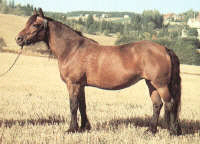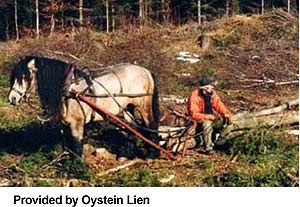

Døle


Introduction: If you have any comments or suggestions, please click here.
Names: Døle, Gudbrandsaal, Døle Gudbrandsdal, Döle Gudbrandsdal, etc. I have decided that these are all the same horse no matter what the words and accent marks look like! I will call it the Døle right now because that is the shortest word with the most common accent mark. One source says that it is also called Ostland Horse or Dølehest. There is also a Døle Trotter, which I will cover on this page until I find enough information to make a separate page for it.
Origin: Comes from Norway. The Gudbrandsdal is known as the Norwegian eastern "valley horse," as distinguished from the Fjord pony of the western coastal region. Whereas the Fjord pony stands only about 56 inches and is of a cream-dun coloration, the Gudbrandsdal is taller, heavier, and dark-colored, with a long, dark mane and tail (the mane not being trimmed short and upright as in the Fjord pony). Both breeds are of ancient origin, probably from the Celtic type that was ancestral to the pony-sized horses of northwestern Europe.
Breeding: A mixture of heavy horses from Denmark, used with some Thoroughbred and Trotter stallions, has produced this breed. Where a larger proportion of Trotter blood is used, the result is the Døle Trotter.
Description: The Døle is a medium sized horse--not unlike a large Fell pony or a less picturesque version of the Dutch Friesian. The Trotter is very hardy with the conformation of an active harness horse belonging to much the same category as the Finnish Universal Trotter. All future breeding stallions have to undergo a test, and are proved over a 1,000 meter track in a race lasting three minutes.
Color: Usually black, brown or bay. Mostly black or brown.
Hair: Flowing mane and tail. Lots of feather.
Size: About 15 hands.
Temperament:
Features: Strong and sturdy.
Uses: Once used for pack work.
Accomplishments:
Curiosities:
Profiles:
Conclusion: